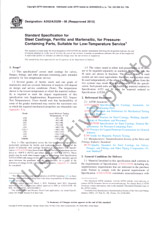We need your consent to use the individual data so that you can see information about your interests, among other things. Click "OK" to give your consent.
ASTM F1962-22
Standard Guide for Use of Maxi-Horizontal Directional Drilling for Placement of Polyethylene Pipe or Conduit Under Obstacles, Including River Crossings
Translate name
STANDARD published on 15.11.2022
The information about the standard:
Designation standards: ASTM F1962-22
Note: WITHDRAWN
Publication date standards: 15.11.2022
SKU: NS-1097241
The number of pages: 18
Approximate weight : 54 g (0.12 lbs)
Country: American technical standard
Category: Technical standards ASTM
The category - similar standards:
Annotation of standard text ASTM F1962-22 :
Keywords:
ICS Number Code 23.040.20 (Plastics pipes)
Additional information
| 1. Scope | ||||||||||||||||||||||||||||||||||||||
|
1.1?This guide describes the design, selection considerations, and installation procedures for the placement of polyethylene (PE) pipe or conduit below ground using maxi-horizontal directional drilling equipment. The pipes or conduits may be used for various applications including telecommunications, electric power, natural gas, petroleum, water lines, sewer lines, or other fluid transport. 1.2?Horizontal directional drilling is a form of trenchless technology. The equipment and procedures are intended to minimize surface damage, restoration requirements, and disruption of vehicular or maritime traffic with little or no interruption of other existing lines or services. Mini-horizontal directional drilling (mini-HDD) is typically used for the relatively shorter distances and smaller diameter pipes associated with local utility distribution lines. In comparison, maxi-horizontal directional drilling (maxi-HDD) is typically used for longer distances and larger diameter pipes common in major river crossings. Applications that are intermediate to the mini-HDD or maxi-HDD categories may utilize appropriate medi equipment of intermediate size and capabilities. In such cases, the design guidelines and installation practices would follow those described for the mini- or maxi-HDD categories, as judged to be most suitable for each situation. 1.3?The values stated in inch-pound units are to be regarded as standard. The values given in parentheses are mathematical conversions to SI units that are provided for information only and are not considered standard. 1.4?This standard does not purport to address all of the safety concerns, if any, associated with its use. It is the responsibility of the user of this standard to establish appropriate safety, health, and environmental practices and determine the applicability of regulatory limitations prior to use. 1.5?This international standard was developed in accordance with internationally recognized principles on standardization established in the Decision on Principles for the Development of International Standards, Guides and Recommendations issued by the World Trade Organization Technical Barriers to Trade (TBT) Committee. |
||||||||||||||||||||||||||||||||||||||
| 2. Referenced Documents | ||||||||||||||||||||||||||||||||||||||
|
We recommend:
Technical standards updating
Do you want to make sure you use only the valid technical standards?
We can offer you a solution which will provide you a monthly overview concerning the updating of standards which you use.
Would you like to know more? Look at this page.




 Cookies
Cookies
